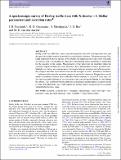Files in this item
A spectroscopic survey of Herbig Ae/Be stars with X-shooter - I. Stellar parameters and accretion rates
Item metadata
| dc.contributor.author | Fairlamb, J. R. | |
| dc.contributor.author | Oudmaijer, R. D. | |
| dc.contributor.author | Mendigutía, I. | |
| dc.contributor.author | Ilee, John David | |
| dc.contributor.author | van den Ancker, M. E. | |
| dc.date.accessioned | 2015-11-02T17:10:02Z | |
| dc.date.available | 2015-11-02T17:10:02Z | |
| dc.date.issued | 2015-10-11 | |
| dc.identifier | 207715498 | |
| dc.identifier | 2db99201-ac94-4647-b736-87658632f5c5 | |
| dc.identifier | 84942342637 | |
| dc.identifier | 000366215500076 | |
| dc.identifier.citation | Fairlamb , J R , Oudmaijer , R D , Mendigutía , I , Ilee , J D & van den Ancker , M E 2015 , ' A spectroscopic survey of Herbig Ae/Be stars with X-shooter - I. Stellar parameters and accretion rates ' , Monthly Notices of the Royal Astronomical Society , vol. 453 , no. 1 , pp. 976-1001 . https://doi.org/10.1093/mnras/stv1576 | en |
| dc.identifier.issn | 0035-8711 | |
| dc.identifier.other | BibCode: 2015arXiv150705967F | |
| dc.identifier.uri | https://hdl.handle.net/10023/7727 | |
| dc.description | JRF gratefully acknowledges a studentship from the Science and Technology Facilities Council of the UK. JDI gratefully acknowledges funding from the European Union FP7-2011 under grant agreement no. 284405. | en |
| dc.description.abstract | Herbig Ae/Be stars (HAeBes) span a key mass range that links low- and high-mass stars, and thus provide an ideal window from which to explore their formation. This paper presents Very Large Telescope/X-shooter spectra of 91 HAeBes, the largest spectroscopic study of HAeBe accretion to date. A homogeneous approach to determining stellar parameters is undertaken for the majority of the sample. Measurements of the ultraviolet are modelled within the context of magnetospheric accretion, allowing a direct determination of mass accretion rates. Multiple correlations are observed across the sample between accretion and stellar properties: the youngest and often most massive stars are the strongest accretors, and there is an almost 1:1 relationship between the accretion luminosity and stellar luminosity. Despite these overall trends of increased accretion rates in HAeBes when compared to classical T Tauri stars, we also find noticeable differences in correlations when considering the Herbig Ae and Herbig Be subsets. This, combined with the difficulty in applying a magnetospheric accretion model to some of the Herbig Be stars, could suggest that another form of accretion may be occurring within Herbig Be mass range | |
| dc.format.extent | 1637379 | |
| dc.language.iso | eng | |
| dc.relation.ispartof | Monthly Notices of the Royal Astronomical Society | en |
| dc.subject | Accretion, accretion discs | en |
| dc.subject | Techniques: spectroscopic | en |
| dc.subject | Stars: early-type | en |
| dc.subject | Stars: formation | en |
| dc.subject | Stars: pre-main-sequence | en |
| dc.subject | Stars: variables: T Tauri, Herbig Ae/Be | en |
| dc.subject | QB Astronomy | en |
| dc.subject | QC Physics | en |
| dc.subject | NDAS | en |
| dc.subject.lcc | QB | en |
| dc.subject.lcc | QC | en |
| dc.title | A spectroscopic survey of Herbig Ae/Be stars with X-shooter - I. Stellar parameters and accretion rates | en |
| dc.type | Journal article | en |
| dc.contributor.institution | University of St Andrews. School of Physics and Astronomy | en |
| dc.identifier.doi | https://doi.org/10.1093/mnras/stv1576 | |
| dc.description.status | Peer reviewed | en |
| dc.identifier.url | http://adsabs.harvard.edu/abs/2015arXiv150705967F | en |
This item appears in the following Collection(s)
Items in the St Andrews Research Repository are protected by copyright, with all rights reserved, unless otherwise indicated.

